Florida’s Fanciest Moths
Moths are often overlooked in favor of showier butterflies, but there are species of moths that stand out for their exceptional beauty and intriguing behaviors.
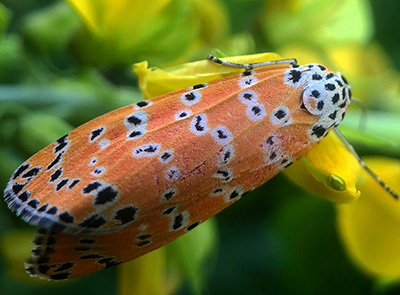
Moths belong to the order Lepidoptera, and are essential pollinators and a food source for many other wildlife species, making them an important part of the food chain. They outnumber butterflies, with over 10,000 species in North America, compared to approximately 700 butterfly species. Among this amazing group, we highlight six of the “fanciest” moths found across Florida.
The ornate bella moth (Utetheisa ornatrix) has a color pallet that includes light pink, yellow, white, and black throughout its distinctive wing pattern. Unlike most moths, the ornate bella is diurnal and is referred to as a “day-flier,” and can be seen more commonly than night-flying species. This moth is small, with a wingspan just over an inch. Feeding mainly on species of Crotalaria, also called rattlebox plants, its larvae ingest toxic pyrrolizidine alkaloids found in the leaves, making them less attractive to predators.
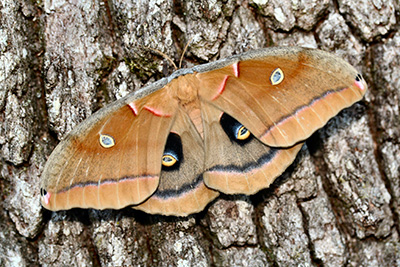
Named after a one-eyed monster from Greek mythology, the Polyphemus moth (Antheraea polyphemus) is large, with a wingspan reaching up to 6 inches. This moth is found in all the lower 48 states except Arizona and Nevada. With red, brown, gray, and yellow pops of color, this moth has a single “eyespot” on each of its wings, like a cyclops. It’s thought that they use their rare pattern to startle potential predators. Polyphemus moths are strongly attracted to light.

The luna moth (Actias luna) is considered one of the most beautiful moths. Found in forested areas, the luna moth has a wingspan of 3-4 inches and moon-like eyespots on both the fore and hind wings. The long, distinctive tail on this moth is used to interfere with echolocation with bats. The males are more yellow-green in color, while the females tend to be more blue-green.
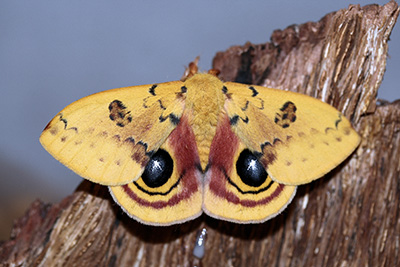
The Io moth (Automeris io) is best known for its prominent hind wing eyespots. Their wingspan is 2-3.5 inches, and the females are larger than the males. The larvae protect themselves by initiating a sting from their venomous spines. Adult Io moths are strictly nocturnal; hiding motionless and unseen in piles of fallen leaves, their coloring blends in perfectly with the brown and yellowing foliage.
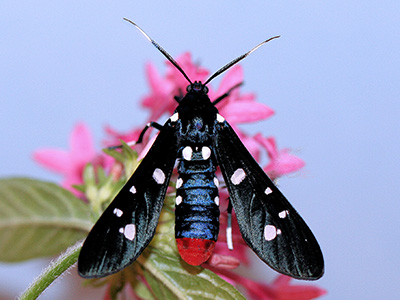
Perhaps better known for its larval state’s destructive appetite, the polka dot wasp moth (Syntomeida epilais) has an iridescent blue coloring, with white dots on its wings and its wasp-like body. Another diurnal species, the slow-flying polka dot wasp moth is active during daylight. The larvae are commonly called oleander caterpillars, for their main food source. An infestation of these caterpillars can defoliate an oleander tree quickly. If you see these caterpillars on your oleander, you can pick them off — unlike many caterpillars, their black hairs are not venomous.
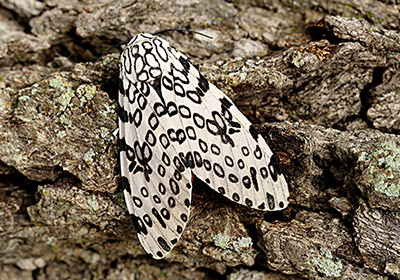
The giant leopard moth (Hypercompe scribonia) is decorated with black spots on its white body and wings. Their wingspan varies from 2.25-3.6 inches and the males are attracted to light at night. The larvae are referred to as giant woolly bears, for the vast number of black hairs on their body. The giant leopard moth actually has ears, to detect echolocation in bats and avoid becoming prey. When threatened, this moth curls its abdomen and secretes a yellow acrid fluid that has a bitter taste.
These are just a few of Florida’s moths. For a broader overview of moths in the region, and how to see them, you can refer to the UF/IFAS comprehensive guide Magnificent Moths: A Guide to Begin “Mothing” and Contributing Your Observations to iNaturalist.
Also on Gardening Solutions
More from UF/IFAS
- Giant Woolly Bear (larva), Giant or Great Leopard Moth (adult) Hypercompe scribonia
- Io Moth Automeris io
- Luna moth, Actias luna
- Magnificent Moths: A Guide to Begin “Mothing” and Contributing Your Observations to iNaturalist
- Oleander Caterpillar, Syntomeida epilais
- Ornate Bella Moth, Rattlebox Moths Utetheisa ornatrix
